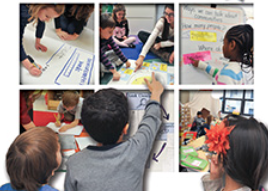Text for Teachers at Grades TK-3
Smarter Charts for Math, Science, & Social Studies: Making Learning Visible In the Content Areas
by Kristine Mraz & Marjorie Martinelli
Preview "Smarter Charts" online
“No matter what area of the curriculum, clear visuals, simple language, and constant reflection on charts are key to helping children gain independence and agency.”

California's content standards tell us that students in primary grades should comprehend informational texts and write informative/explanatory texts with steadily increasing proficiency. Our young students should build knowledge about a topic by gathering information, making notes, and organizing their thoughts to produce writing that conveys a clear message. These are achievable goals, but the standards themselves provide few specific activities that teachers can use to help struggling writers achieve these objectives.
Using charts that are co-created by everyone in the room, Kristi Mraz & Marjorie Martinelli demonstrate methods that make thinking and learning visible for students. Through chart- related activities, they show how we can help all students develop critical thinking and organizational skills, building a bridge that can transport children into the world of nonfiction reading and writing.
With dozens of examples from the content areas, the authors share step-by-step instructional methods that help teachers tap the hidden power of charts – turning complex ideas into kid-friendly visuals, helping children internalize content processes, building student's graphic literacy skills, and saving valuable instructional time.
But some of us can't draw. No worries! Kristi and Marjorie teach us how to use symbols and quick drawings to communicate ideas to even the youngest, emergent readers... But some of us are overly wordy. No worries! Kristi and Marjorie teach us how to distill our most important points on a chart... But sometimes our kids don't use our charts. No worries! Again, the authors have us covered, sharing practical ways to co-create charts with students and teach them how to use them well. Online video tutorials enhance
Five in-depth sections provide specific methods to support mastery of Routines, Genres and Concepts, Processes, Repertoires of Strategies, and Exemplars. Each section includes a “Charts in Action” lesson transcript that shows how the teacher can build engagement, reinforce learning, and support independence by gradually releasing the management of the chart to the learners.
In Smarter Charts, Marjorie and Kristi use their knowledge of language development, brain research, and best practices to help us chart a new course for teaching and learning.
Updated: May 12, 2023